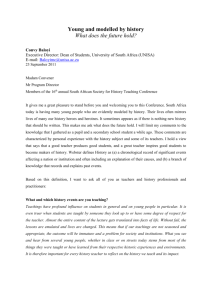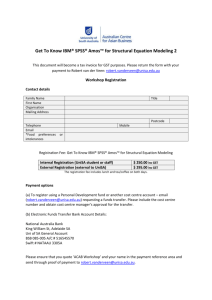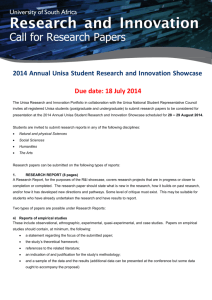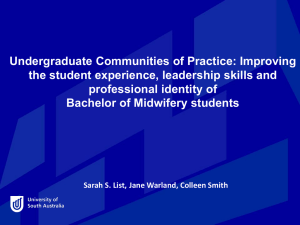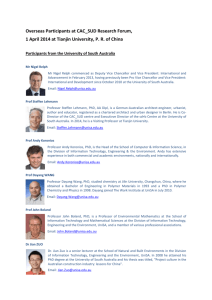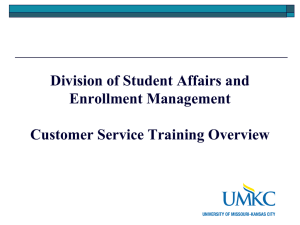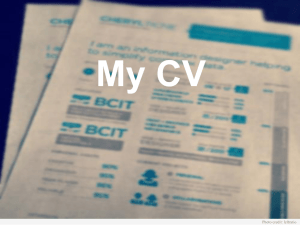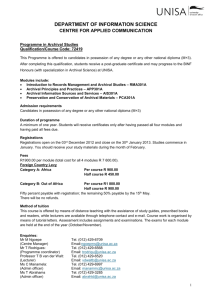Ms Joyce Mohapi & Mr Mzamane Baloyi
advertisement
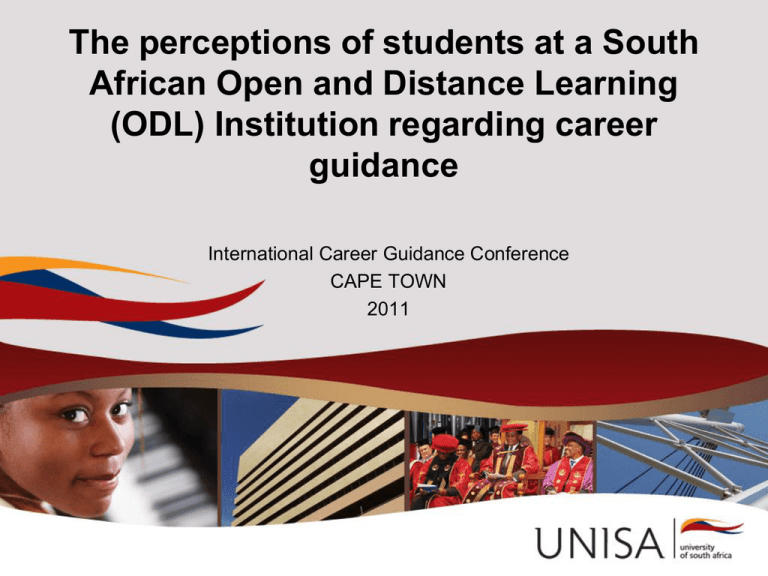
The perceptions of students at a South African Open and Distance Learning (ODL) Institution regarding career guidance International Career Guidance Conference CAPE TOWN 2011 Authors: B. Joyce Mohapi Department of Social Work M. Convy Baloyi Executive Director: Dean Of Students Contents • • • • • • Introduction The Unisa Context Aim of the study Methodology Results of the study Conclusion Introduction • The importance of career guidance in higher education influenced by change in student profiles • Students are more diverse, and career guidance and counselling needs to be responsive to the changing profile of students (Lairio & Penttinen, 2006). • Need for Universities to invest resources in developing and implementing career guidance. Career Guidance • Career guidance includes a range of services which are aimed at assisting students to make educational and occupational choices and to manage their careers (Watts and Sultana, 2004). • This means that career guidance should facilitate the process of choosing the correct field of study at a University, and by so doing assist in choosing a suitable occupation. These services may be face-toface or offered in a distance mode. • Career guidance should have the aim of increasing the students’ readiness to make decisions relating to careers (Pace Career Centre, 2004). Ethiopia 941 Zimbabwe 9962 Swaziland 1425 Namibia 2062 Lesotho ??? UK 943 Switzerland 49 Spain 10 Scotland (UK) 11 Germany 124 England (UK) 112 United Arab Emirates 239 Thailand 18 Taiwan 45 South Korea 48 New Zealand 144 Unisa in Africa Americas 460 & abroad Canada 124 USA 298 Australia 305 South Africa 262518 Department of Information and Strategic Analysis Career Guidance at Unisa • At Unisa, the career guidance function is located under Directorate: Counselling, Career & Academic Development (DCCAD). • It is under the Department of Tuition and Facilitation of Learning • This Directorate offers career, academic and personal counselling in-person, electronically, by fax and post. • Prospective students are reached and served through the dissemination of information by means of the media mentioned above as well as visits to schools and participation in careers exhibitions or fairs. • Registered students through the described media with particular emphasis on the development of Internet links which are only now slowly taking off overseas. Aim of the study To explore the perceptions of students at an open and distance learning institution in South Africa regarding career guidance. Research Question “What are the perceptions of Unisa students regarding career guidance?” Data Collection •A quantitative study •Used a survey design to collect data from students registered at the University of South Africa, which is the only Open and Distance Learning University in South Africa. •A questionnaire was distributed electronically to students in the different regions of the University. •The questionnaire had two sections: the first section focused on the biographical data of respondents, and the second section had questions which focused on the respondents’ awareness and perceptions regarding career guidance services at the university. Data collection •The respondents were from the different colleges in the University, namely, the College of Human Sciences, College of Law, College of Economic and Management Sciences, College of Agriculture and Environmental Sciences, College of Education, and the College of Engineering, Science and Technology. •The data was analysed using tables, graphs and diagrams. •There were 99 respondents from the regions of Gauteng, Kwa-Zulu Natal, Mpumalanga and NorthWest. Data presentation Data collection • Respondents’ perceptions regarding career guidance – Questions were posed to respondents relating to the importance of career guidance, awareness regarding career guidance services and the usefulness of the information received. – The responses are given in the following tables and figures: Data presentation Research results Additional Comments: •Respondents were requested to make additional comments. •The comments made are summarised below •Sharon Hempsey should be promoted •More involved with students •Visibility on campus •Satisfied with service •Poor service •CSET needs more companies at expo •More information about career guidance before the expo •Need counselling Findings • • • • • • • Several issues emerged from the study which are relevant to the practice of career guidance at the University of South Africa. It is clear that the majority of students regard career guidance as essential, and that this practice should continue. The information received from the career guidance practitioners is also valued, as it is regarded as helpful. Awareness regarding career guidance services was relatively lower, and this may be an indication that there should be more visibility or reaching out to students using different modes (face to face or computer based services). Since Unisa is an Open and Distance Learning Institution, the use of technology could be used more in reaching out to students in all the regions. More careers guidance practitioners could also based at different regional offices to offer a face to face service to students who are outside the main campus. The above is also confirmed by the Bureau of Market Research (2010) which found that awareness regarding career guidance was not rated as “extremely important” but more as “important” and “less important”.. Findings • The ability of students to make choices based on information received from the career guidance section was also relatively low. This is an indication that the information received was insufficient. This is also confirmed by the Bureau for Market Research, Unisa (2010) which states that students think that staff members do not have sufficient knowledge to address student enquiries on course content. • The report further states that “ some students perceived staff as incapable of assisting with course choices relevant to career aspirations mainly due to lack of exposure and insight into certain highly specialised fields such as engineering, science and technology”. • The above has implications for staff training in the field of career guidance, and continuous updating of information on new fields. Conclusion • The study achieved its aim of exploring the perceptions of students regarding career guidance, and also provided and answer to the research question. • It also raise issues which may be researched further to shed more light on the subject of career guidance practice at an Open and Distance Learning institution of higher learning. We thank you Joyce Mohapi Convy Baloyi

